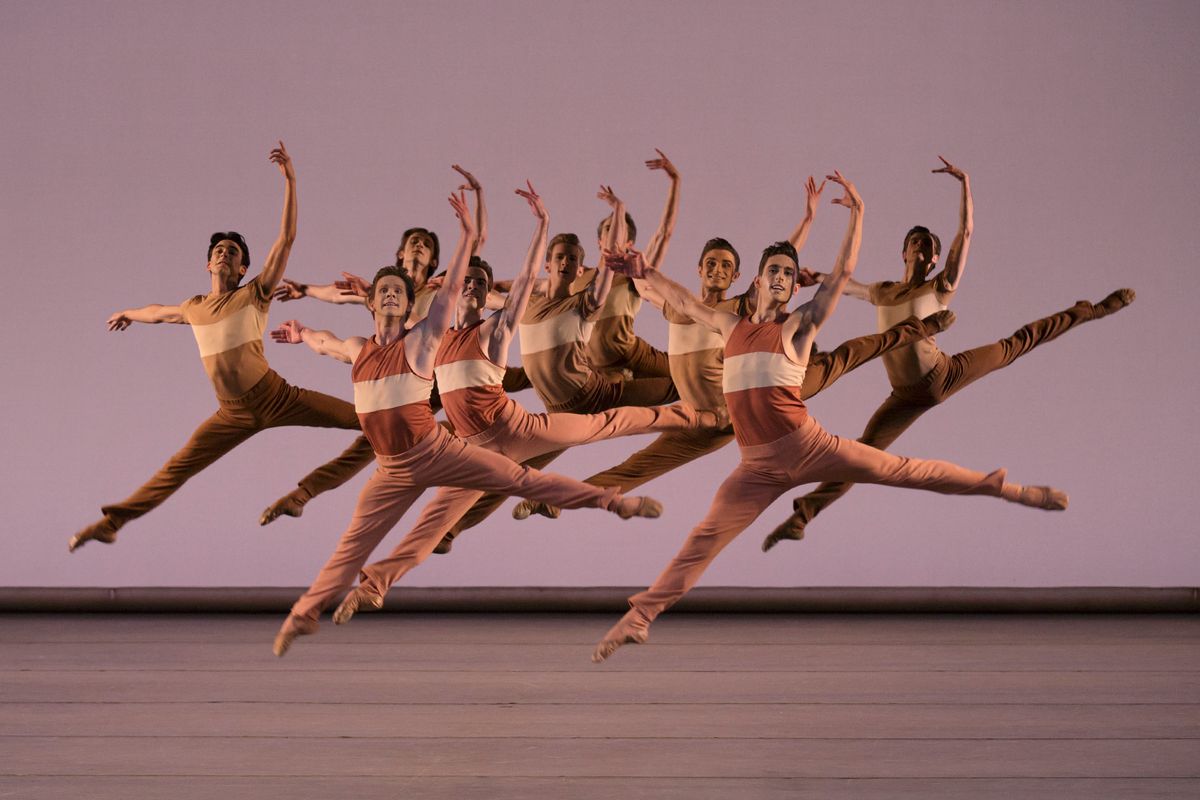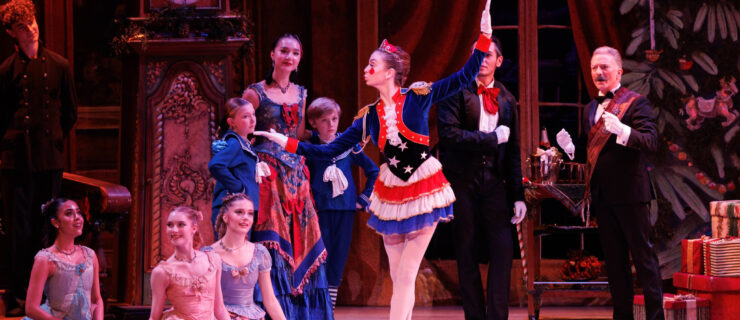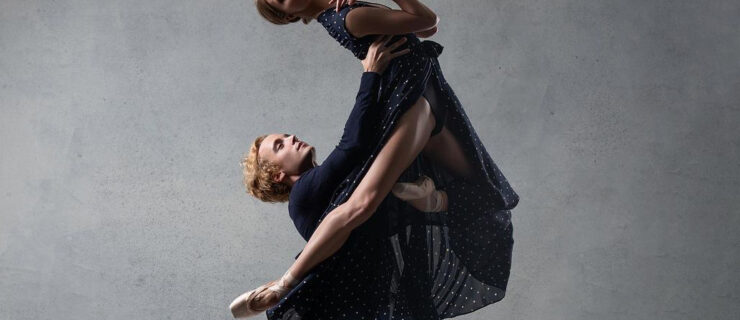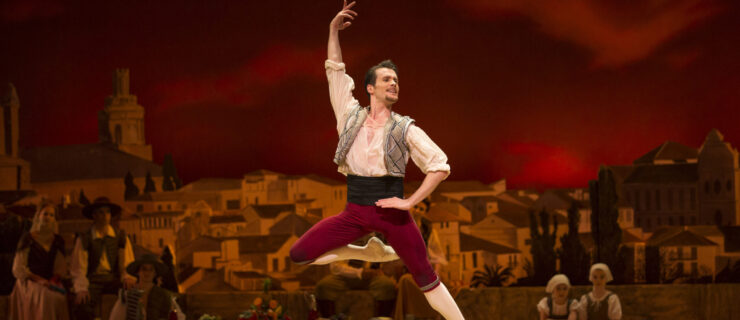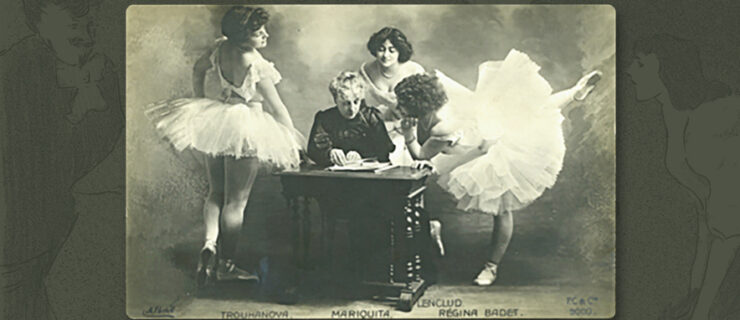Truly Exceptional: Our Top 12 Standout Performances of 2015
This story originally appeared in the December 2015/January 2016 issue of
Pointe.
What left us breathless and wanting more.
Carrie Imler & Jonathan Porretta

Perfectly matched: Poretta and Imler in Forsythe’s In the middle, somewhat elevated. Photo by Angela Sterling, Courtesy Pacific Northwest Ballet.
Whenever Pacific Northwest Ballet principal dancers Carrie Imler and Jonathan Porretta take the stage together, the audience expects a great performance. The veteran company members are longtime friends as well as frequent partners, and their ease with choreography and one another always shows. But their technical confidence and mutual trust reached rarefied heights in PNB’s all–William Forsythe program last March.
The duo were paired in all three dances on the bill, and their pas de deux in New Suite, in particular, showcased them at the height of their careers. Imler and Porretta not only handled Forsythe’s demanding choreography with ease, but they infused it with an obvious love for the movements, for one another and for the audiences. The joy they brought to the program was contagious, leaving the crowd giddy with excitement as they left the theater. —Marcie Sillman
Alessandra Ferri

Master of her craft: Ferri in Woolf Works. Photo by Tristram Kenton, Courtesy ROH.
Alessandra Ferri has long transported us in roles of larger-than-life passion. But portraying Virginia Woolf, a woman who writes difficult novels—that’s possibly even harder to pull off. For Woolf Works, Wayne McGregor’s first full-length for The Royal Ballet, he insisted that Ferri, 52, be his star. And she fulfilled this assignment with flying colors. As she stood behind a scrim of jumbled words, we sensed her alertness to language. When she extended her lower leg toward the floor, it was not to show off her exquisite instep, but to point to something she’d observed with a writer’s eye.
In the third act, based on Woolf’s novel The Waves, Ferri projected a feeling of being at one with the water. As she partnered with Federico Bonelli, she swirled with a natural ebb and flow, occasionally dragged by an undertow. Although we knew this was her character’s chosen way of dying, there was something serene about the way she finally got pulled under. Ferri invited you into the tragedy with a lyrical intensity. —Wendy Perron
Matthew Rich

Rich made his last Cedar Lake performance unforgettable. Photo by Shoko Takayasu, Courtesy Jenny Lerner.
The gloomy crowd that shuffled into the Brooklyn Academy of Music in June looked like a funeral procession. They were there to see Cedar Lake Contemporary Ballet’s final performances; they were prepared to grieve.
Instead they found joy, of a deliciously campy variety, in Richard Siegal’s adrenaline rush of a world premiere, My Generation. And especially in Matthew Rich, the ringleader of its Technicolor circus. Hair whipping, limbs lashing, Rich attacked the choreography with the full-body exuberance that had become his signature during his decade with Cedar Lake. He has the rare ability to be at once arch and earnest, to give us a sly wink even as he’s selling the heck out of Siegal’s over-the-topness. Somehow, he managed to make lip-synching along to The Who’s “My Generation” look, well, cool. It was his party—and nobody was crying. (There’s no need for Rich fans to cry now, either: He’s taken his considerable talents to BODYTRAFFIC in Los Angeles.) —Margaret Fuhrer
Misty Copeland

Grace under pressure: Copeland (with James Whiteside) in Swan Lake. Photo by Gene Schiavone, Courtesy ABT.
Fans of American Ballet Theatre’s Misty Copeland would have cheered at anything she did, so it was automatic that her first Swan Lake in New York City would get a standing ovation. But Copeland’s sold-out debut was also artistically satisfying, especially her Odette. For a dancer who consistently brings fire and joy to the stage, portraying the white swan was a challenge. But coached by ABT ballet master Irina Kolpakova and artistic director Kevin McKenzie, Copeland took her time expressing Odette’s sadness of being under a spell. Her long limbs extended into space with pathos, settling into exquisite lines. Her head and neck were beautifully expressive, and she took comfort in her closeness to Prince Siegfried (danced with ardor by James Whiteside). Her magnificent timing allowed us to feel the pull between fear and hope, sorrow and romance.
As Odile, Copeland lost her balance during her fouettés, finishing with pirouettes from fifth—yet she remained unshaken and in character. Her artistry under pressure obliterated any worries about whether she deserved her promotion to principal—the first African American woman at ABT to do so—less than a week later. —Wendy Perron
The Men of Justin Peck’s Rodeo: Four Dance Episodes

A true band of brothers: NYCB’s men in Rodeo: Four Dance Episodes. Photo by Paul Kolnik, Courtesy NYCB.
George Balanchine found rich inspiration in sisterhood, in the strong female communities of Serenade and Concerto Barocco. So when New York City Ballet premiered Justin Peck’s Rodeo: Four Dance Episodes—a ballet with a cast of 15 men and a single woman—its band of brothers immediately drew comparisons to Mr. B’s women.
But Rodeo, set to Aaron Copland’s famous score, is as much a celebration of NYCB’s current crop of men as it is a reimagining of the old Balanchinean model. And what men they are! Several principal dancers—including Daniel Ulbricht and Andrew Veyette—lead the pack, bringing sunny energy and powerful athleticism to the first and last episodes. (Ulbricht’s series of decelerating turns in the final movement is as funny as it is astonishing.) The heart of the ballet, though, lies in the lyrical second episode, which Peck devotes to a quintet of non-principals: Daniel Applebaum, Craig Hall, Allen Peiffer, Andrew Scordato and Taylor Stanley. These five find poetry in the choreography’s gentle rises and falls, tenderness in its velvety partnering. Together, they paint a sensitively shaded portrait of male intimacy. —Margaret Fuhrer
Emily Bromberg

Bromberg with Andrei Chagas in Heatscape. Photo by Leigh-Ann Esty, Courtesy MCB.
Last spring, in the light-pierced kaleidoscope that is Justin Peck’s Heatscape, Miami City Ballet’s Emily Bromberg, then still a corps member, glowed. As the lead ballerina in the opening movement, she was a convivial member of a streaming-by posse before commanding center stage with her smitten partner—vital for the democratic dynamics of the choreography. Bromberg’s speed, sharp transitions and projection (those jumps with her eyes set on heaven!) have been honed in MCB’s Balanchine aesthetic. But this recently promoted soloist also draws elegance from her Kirov Academy of Ballet training in Washington, DC. And Heatscape has helped catapult her career. “I gained a sense of freedom from this that I didn’t always trust before,” she says. Through her poise, agility and emotional translucence, she reached timeless beauty as an artist. —Guillermo Perez
Laura Hecquet

An étoile is born: Hecquet in her Swan Lake debut. Photo by Ann Ray, Courtesy POB.
After dancing many years as an anonymous swan at the Paris Opéra Ballet, there was a sense of vindication to Laura Hecquet’s authority as Odette/Odile in Swan Lake last March. At 30, Hecquet proved she is one of the purest exponents of the French school today, all smooth precision, with fouettés like clockwork. And her instinct for tragedy signaled a born principal: Hecquet’s Odette understood her fate from the start, and drew the audience in with elegiac adagio work.
Like her classmate, San Francisco Ballet principal Mathilde Froustey, Hecquet was pegged as a future star when she graduated from the POB School in 2002. A decade as a sujet and a serious knee injury later, it seemed like the company would never give her the opportunity to prove herself. Benjamin Millepied promoted her as soon as he was appointed director last year, however, and again to étoile after her Swan Lake debut—overdue recognition for a ballerina who has long been a class act. —Laura Cappelle
Victoria Hulland

Total focus: Hulland with Ricardo Rhodes (left) and Ricardo Graziano in Monotones II. Photo by Frank Atura, Courtesy Sarasota Ballet.
When The New York Times dance critic Alastair Macaulay named Sir Frederick Ashton the ultimate poet of line in his review of Sarasota Ballet at Jacob’s Pillow Dance Festival this summer, he must have been talking about principal dancer Victoria Hulland. As the sole female in the central pas de trois of Ashton’s Monotones II, Hulland was a breathtaking study in total concentration. Every second of Ashton’s masterwork was performed with equal attention, whether she was reaching for a partner’s hand or being lifted from the floor in a dramatic split. And while Ashton’s ballet may be spare, it is not cold. Hulland’s exactitude and restraint supported the stage’s lunar atmosphere with an otherworldly elegance, as if she were an interstellar acrobat from the deep cosmos. She understood Ashton’s approach to abstraction, which always feels human, while her musicality mined the wistful, melancholic spaces in Erik Satie’s haunting Trois Gymnopédies. —Nancy Wozny
Andreas Kaas

One to watch: Kaas in The Flower Festival in Genzano. Photo by Kyle Froman for Pointe.
When The Royal Danish Ballet: Principals and Soloists brought their self-produced all-Bournonville program to The Joyce Theater last January, they brought along promising corps de ballet dancer Andreas Kaas. And Kaas—who had plenty of featured stage time—more than kept up with his colleagues. A product of the Royal Danish Ballet School, he demonstrated tireless command of Bournonville’s vigorous batterie; his explosive jump etched clean lines with diamond-cut precision. But more than that, he was completely invested and alive in whatever role he played. In the pas de deux from The Flower Festival in Genzano, he was sweetly attentive towards his partner (the equally impressive Ida Praetorius), a young lover consumed with affection. He burned with good-humored competition in Bournonville’s high-stepping “Jockey Dance,” and, later, kicked off the tarantella from Napoli with joyful enthusiasm. In an exuberant program full of company stars, it was apparent that Kaas’ own is quickly on the rise. —Amy Brandt
Kara Wilkes

Going all in: Wilkes with Robb Breseford in Writing Ground. Photo by Margo Moritz, Courtesy Alonzo King LINES Ballet.
Few dancers can master the squiggly, daredevil choreography of Alonzo King, including his 2010 ballet Writing Ground. But for Kara Wilkes, a four-and-a-half-year LINES Ballet veteran, the intense emotionality required for the piece’s final movement proved more difficult. In it, four men partner (read: pull, lift, prod, catch, support) Wilkes—though it’s not often clear if her character is aware of her surroundings. “At its core, the role represents the spectrum of the human experience,” Wilkes says. “Sometimes my character is strong and she knows where she’s going. Other times she feels tender, vulnerable—even blind.”
Wilkes compares the role (which includes laughing onstage and talking to herself) to swimming in the ocean. But there’s something extra eerie about watching a ballerina exquisitely extending her leg one second and scribbling imaginary poetry on the ground the next. It takes courage as a performer to lose one’s self completely onstage, and Wilkes went all in, shedding her carefully honed technique for moments of utter realness. —Jenny Ouellette
Dana Benton

Steely precision: Benton (with Brandon Freeman) in Traveling Alone. Photo by David DeSilva, Courtesy Amy Seiwert’s Imagery.
In Amy Seiwert’s Traveling Alone, Dana Benton is a force to be reckoned with. The Colorado Ballet principal, who originated the role with CB in 2012, performed as a guest with Amy Seiwert’s Imagery during the company’s Joyce Theater debut in August. And though she is petite, with textbook-perfect lines, Benton’s dancing was anything but small. She was especially thrilling in the solo moments. Benton attacked Seiwert’s precise choreography with ownership, slicing through the air with angular arms and legs, dropping through surprising level changes and luxuriating in off-center balances. While many contemporary ballets rely on ultra-pliable ballerinas to create a central pas de deux, Benton’s steely soloing was a refreshing show of strength and confidence. —Nicole Loeffler-Gladstone
Dores André

André, shown here in rehearsal, was a musically nuanced Juliet. Photo by Erik Tomasson, Courtesy SFB.
San Francisco Ballet–goers have come to expect fluid, intelligent dancing from Dores André; with her bent for the contemporary, the 11-year veteran has made a mark in dozens of new and neoclassical works. But when she debuted as Juliet, one of her first performances after being told that she would be promoted to principal dancer at the end of last season, the Spanish-born ballerina reintroduced herself as a compelling actress in command of an earthy, expressive musicality. She read Prokofiev’s score like a storybook, dancing with a sensitive timing that revealed nuances hidden in its lilting airs and clashing phrases. Immersed in the music, André drew us into Juliet’s emotional world, and we hung on her every step—experiencing her star-crossed arc from naiveté to longing to anguished maturity as if for the first time. —Claudia Bauer
